First Build: Seven Foundation Principles for Spiritual Builders
Part of a yearlong series about building and builders inspired by the Torah cycle.
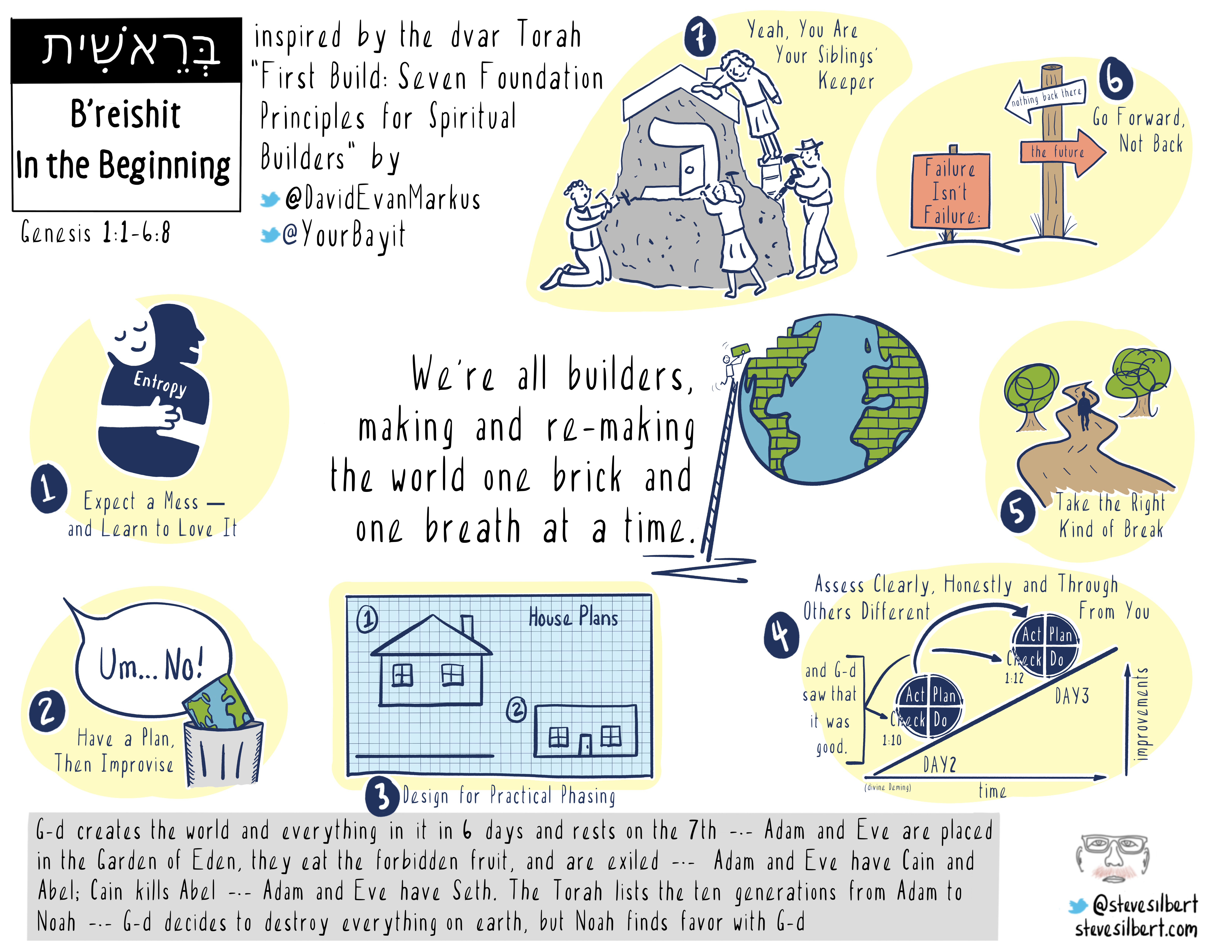
We’re all stardust, re-mixed chemical elements forged in some distant supernova. We’re all broken shards, fallen from the primordial shattering. We’re all reflected light, glimmering with the Source of Light. We’re all builders, making and re-making the world one brick and one breath at a time.
Whatever your metaphor for who we are and what we do, your metaphor probably grounds in the foundation of some first principle – some First Build of mind and identity.
For us at Bayit, our first principle is that we – us and you – are builders of the Jewish future. So this year, for a whole year, we’ll mine Torah’s wisdom for lessons about building and builders.
As the Torah cycle begins anew with Parshat Bereishit, we begin as Torah begins – with the primordial building story that is the Creation at Torah’s very beginning (“a very good place to start“). One translation opens, “When God began to create heaven and earth, the land was a jumbled mess, with darkness on the face of the deep. And the spirit of God hovered…” (Gen. 1:1-2). Then came light, sky, sea, land, vegetation, stars, sun and moon, fish and birds, land creatures and first humans – a primordial building of sorts.
Reading this Creation story through a builder’s lens, we needn’t be architects or contractors to find a master plan for how to build. Here are seven foundation principles for building the Jewish future.
- Expect a Mess – and Learn to Love It.
Look carefully: Creation began not by making a jumbled mess but from a jumbled mess. The mess pre-existed Creation! Rabbi Brad Artson, Dean of the Ziegler School of Rabbinic Studies, famously teaches that we – and divinity, and everything in the world – are in the “chaos to cosmos” business. Because chaos pre-existed creation and inheres in creation, the definition of soulful “building” is to use tools that evolve chaos toward order. But chaos and disorder aren’t enemies: they’re the foundation of all creation and all building. Put another way, physicists meet Artson at the Second Law of Thermodynamics: chaos (“entropy”) inherently increases in any system, and without it Creation would get stuck. Thus, everything we ever could build rests on a shaky foundation – and that’s great! We need disorder’s arrow to slowly wear down everything one builds to keep us priming the pump of energy, building and re-building for tomorrow rather than yesterday.
That’s why every builder must learn to love entropy – or in Clay Christensen‘s economics language, every builder must learn to love disruptive innovation. If we do, then we’ll build in ways that are naturally flexible and open, with give in the joints rather than excess inner fixity that can become brittle. We’ll learn to build not any “one and done” structure but rather as an unending process of inclusion, a lifestyle rather than a fixed structure. That’s why Jewish life always must be “under construction.”
- Have a Plan, Then Improvise.
Medieval mystics read the Creation story as a blueprint, a plan in the Divine Mind that preceded the actual work. Building starts not with the first nail, but with the first inner impulse that ripens into an image – then a plan, then the first nail. While plans can be designed as flexible, much like jazz can riff off a musical structure, plans and structures have their place. Any other result is mere chaos or avant garde masquerading as creativity.
Medieval mystics also read the Creation story as a first attempt and then second attempt. Genesis 1 tells a different Creation story than Genesis 2, which inspired sacred myths that God tried a first Creation, failed and then tried a second Creation. While the Documentary Hypothesis has much to offer about how Torah was edited and canonized, the telling of this “second Creation” approach over the centuries – about an ostensibly perfect God who’d try, fail and try again – should get our attention. If God can try and try again, and not be irrevocably wedded to a “first Creation,” perhaps we can hold our building a little gently too.
- Design for Practical Phasing.
Imagine if Creation had started with humanity, then vegetation, then firm land, then the sun, then light. Of course it couldn’t work: primordial humanity would have no land to stand on or food to eat; then food would exist but float without land or sunlight by which to grow; then the sun would glow but dark. None of this makes sense, which is the point. Creation reflects the need to think ahead and build in sequence based on function. Just as contractors can’t raise a roof without walls, or walls without a foundation, so the building of Jewish life needs a functional and rational sequence.
What does your creation need as its foundation? What steps must follow? How will your design-build process evolve necessary structure to enforce that sequence, without becoming so rigid that the building loses joy and needed flexibility? The reason so many ideas fail isn’t the idea but the execution. Buildings without good grounding and disciplined construction tend to be mere castles in the sky where nobody can live, or sand castles too easily eroded.
- Assess Clearly, Honestly and Through Others Different From You.
The Creator didn’t just create and pack up. After each phase of building, the Torah narrative stops and recounts that “God saw that [the current phase of creation] was good.” Why? It’s not enough to build: builders also must take stock and be accountable – to original plans, to the actual thing being built, to users and to history. If medieval mystics got it right, then maybe the Creator’s “first creation” was adjudged unworthy and insufficient.
But frank assessment is hard. Often we see ourselves in what we create, and we judge our creations either too charitably or too harshly based on how we see ourselves. In this understanding, only God is a perfect witness and mirror (Ibn Ezra, Gen. 1:4): everyone else needs clear assessment tools that don’t depend on self-assessment or groupthink.
- Take the Right Kind of Break.
Building is perpetual – forever under construction – but not necessarily continuous. Even the Creator modeled taking a day off. Jewish tradition calls it Shabbat, and on that day God “rested” (Gen. 2:2-3) – or sat, or returned – and then “re-ensouled” (Ex. 31:17).
Every builder needs time off from building, but for the sake of taking a specific kind of breather. The “breather” that builders need is the re-ensouling kind – the kind that honors the ebb and flow of the creative impulse, the kind that incubates the next pulse of creation, the kind that comes from soulfulness rather than mere industry, ambition or momentum. Figure out what that kind of “breather” means for you: it probably won’t mean just sitting there.
- Failure Isn’t Failure: Go Forward, Not Back.
Some things won’t work, but that’s not failure if we learn and adapt. Theologians and Biblical scholars might debate forever whether God’s tussle with Adam and Eve in the Garden of Eden was a “failure” and, if so, whose failure. (Far from a “fall from grace,” maybe God intended or even hoped that fledgling humanity would eat the “forbidden fruit” and attain consciousness: how often did you learn only by pushing back?) Regardless, the point was to go forward: whatever happened in Eden, there was no going back. The Creator even positioned cherubim with flaming swords at Eden’s entrance to block their way back (Gen. 3:24).
So too for our own building adventures. When things don’t go as planned, there’s no going back – and, what’s more, we needn’t want to. Whatever breaking or mishap life may bring, there’s a future waiting to be built – and it’s important enough to merit angels stationed to point the way.
- Yeah, You Are Your Siblings’ Keeper.
Build teams are teams. The rhetorical question that Cain asked God after killing his brother, Abel – “Am I my brother’s keeper?” (Gen. 4:9) – has echoed throughout history. And the Creator’s tacit answer is yes: we’re not meant to build alone, and jealousy has no rightful place in building the future. The human-spiritual design so plainly intends us to be and build in community that even Cain, destined to wander aimlessly, miraculously settled down with a wife (created by Whom?) and birthed a new lineage.
So take care of your build team, even and especially when relationships tug and fray. More than any building, the team is any builder’s greatest legacy.
*
Welcome to this new year of building together – with beloved messiness, plans carefully crafted and ditched, practical phasing, frank assessment, wise breaks, leaning forward beyond failure, and caring for each other. Now, let’s pick up a hammer: next week, there’s an Ark to build.

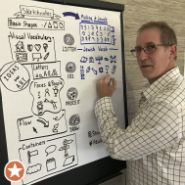
By Rabbi David Markus. Sketchnotes by builder Steve Silbert.

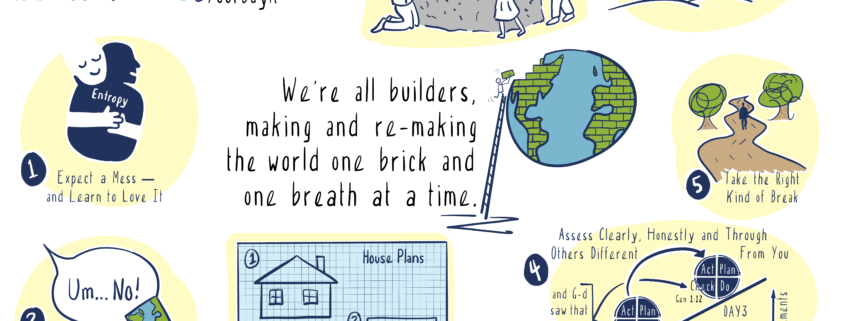
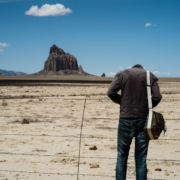


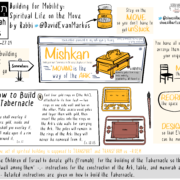




Trackbacks & Pingbacks
[…] wisdom is embedded in Bayit’s founding principles. Every build needs a team, and “[m]ore than any building, the team is any builder’s greatest legacy.” As we do the work of spiritual building — both building the spiritual future, and doing the […]
[…] Bayit’s Builder’s Blog harvested keystone principles about building the Jewish future – from primordial foundations of building, to where and with whom spiritual neighborhoods create […]
[…] Bayit’s Builder’s Blog harvested keystone principles about building the Jewish future – from primordial foundations of building, to where and with whom spiritual neighborhoods create […]
[…] be building — rather that life is full of surprises. In Bereshit we were reminded that even God needs a plan B sometimes: clearly this is part of creation’s design. We can’t prepare for every eventuality, but we can […]
[…] Originally published at Builders Blog. […]
[…] First Build: Seven Foundation Principles for Spiritual Builders […]
Comments are closed.